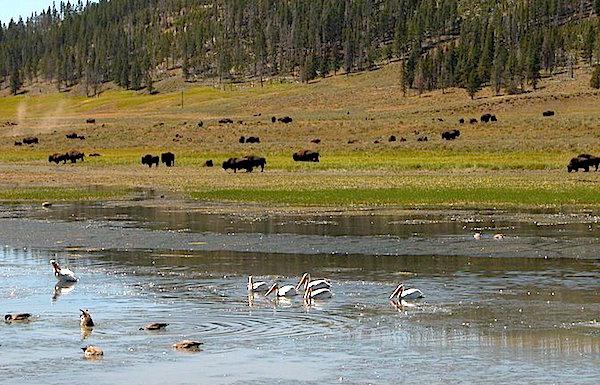
While many Yellowstone visitors focus on bison, American White Pelicans are another interesting aspect of the park's wild kingdom/Kirby Adams
It's a warm summer day and I'm enjoying excellent views of pelicans, gulls, terns, and other waterbirds. Which national park am I in?
There are clearly many possibilities. Everglades National Park comes to mind, or perhaps Padre Island National Seashore, or any of the national seashores. All are likely places to spend a day watching an assortment of waterbirds. But the scene above is from none other than Yellowstone National Park.
Waterfalls, canyons, geysers, and megafauna are undoubtedly the calling cards of Yellowstone. You don't hear much about the birds, and when you do it's the eagles, owls, and birds of the coniferous forests. It's easy to forget there's a huge lake in the park. With lakes come waterbirds.
The first group of American White Pelicans I ever saw was in a pond along the road from Canyon to Norris. At the time, I thought pelicans were a feature of the Gulf Coast; and they are, but those are usually Brown Pelicans. The American White Pelicans winter on the seashores, but they are summer denizens of the plains and mountains. The juxtaposition of bison and pelicans was perfectly normal, but I didn't know that and snapped a documentary photograph. Now that I know that some of the largest pelican breeding colonies in North America are in North Dakota, right near the geographic center of the continent, it seems silly to have been surprised to see them in Yellowstone.
The pond I saw those pelicans in was little more than a puddle in a field, but one of the largest puddles in the Rocky Mountains was nearby. Yellowstone Lake has hosted a breeding colony of pelicans and waterbirds since near the time of the park's creation. Little data exist before 1890, but it's likely the birds have been using the spot for some time. The Molly Islands of the lake's Southeast Arm have been the traditional nesting site of American White Pelicans, California Gulls, Double-crested Cormorants, and Caspian Terns.
The colonies have typically been cyclical in their success, with some years producing abundant nest success and others with no offspring produced at all. The past twenty years, however, have shown a trend of steadily declining success with few productive seasons. It's been a decade since Caspian Terns nested on the Molly Islands.
Reasons for the decline are not completely understood. It is known that high lake levels flood the islands, making nesting impossible. Record snowfalls and heavy melts have caused island-flooding lake levels in recent years. It's also thought that high lake levels reduce the foraging territory of the pelicans which like to scoop fish from shallow areas.
Other theories involve an abundance of Bald Eagles having an impact on the trout population that supports the waterbirds.
A summary of research on the Molly Islands bird colony by wildlife biologist Lisa Baril appeared in a special climate change issue of Yellowstone Science this past March.
Regardless of the causes, it seems the pelicans of Yellowstone may not be producing as many offspring as in the past, making the pelican and bison photos a little more difficult to snag. For the time being, however, Yellowstone Lake and Jackson Lake in Grand Teton National Park remain two of the best and most scenic spots in the country to see American White Pelicans in the summer.



Add comment